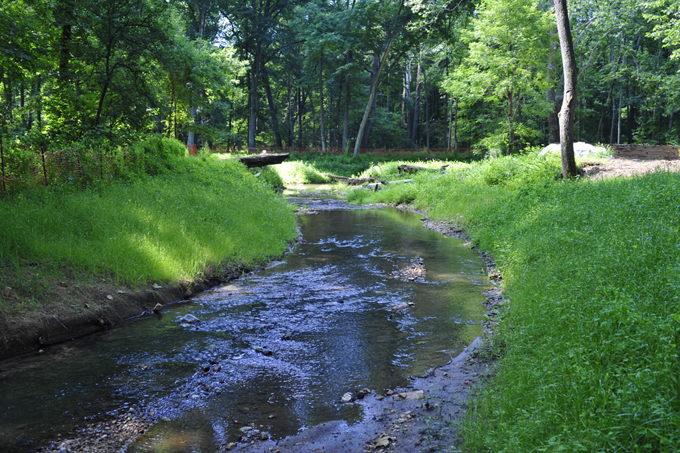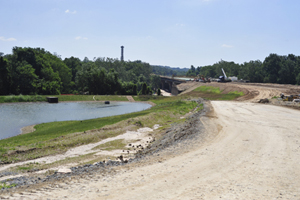
The Northwest Branch stream in Montgomery County is undergoing $5.3 million worth of improvements by the Maryland State Highway Administration. (Photo by News21’s Jason Lenhart.)
Scientists Say Standards Lacking in Stream Restoration
Rabiah Alicia Burks
News21 Staff

Maryland is building the 18-mile Intercounty Connector just a few miles away from Northwest Branch. (News21 Photo by Jason Lenhart)
Northwest Branch was eating away at itself.
Every time it rained hard, the otherwise placid stream in the Maryland suburbs of Washington would surge with runoff from surrounding lands. The swollen creek chewed away at its banks, muddying the water and weakening trees by exposing their roots.
Such eroding streams are common sights in the Chesapeake Bay region, and a major threat to the bay’s water quality. Experts estimated that Northwest Branch was pulling 1,700 tons of sediment annually—the equivalent of 17,000 dump-truck loads — into its waters and sending it downstream into the Anacostia River and ultimately the bay.
Now the Maryland State Highway Administration is pouring $5.3 million into fixing the stream’s erosion problems, essentially by tearing up and rebuilding 3.4 miles of banks along the 19-mile stream. It’s part of how the state is meeting regulatory requirements that it offset environmental damage caused by construction of the Intercounty Connector, an 18-mile toll road being built across Montgomery and Prince George’s counties.
State officials say that once completed, their Northwest Branch stream restoration project should stabilize the stream’s banks and cut the sediment loss by more than half.
But others are not so sure, and question how much of the untold millions invested in stream restoration efforts in the Chesapeake region –and the billions spent on such projects nationwide-- is being spent wisely.
Across the United States, thousands of stream restoration projects have been undertaken in the past two decades. Many are designed to satisfy regulatory “mitigation” provisions of the Clean Water Act, which require highway agencies, developers and other government and private entities to make up for any harm they’re doing to streams and wetlands by launching special improvement projects. Some of the mitigation projects involve work on entirely different streams from the ones damaged by the original projects.
Given the amount of money being poured into fixing streams, scientists say there is a surprising lack of national standards, measurable goals, monitoring and thorough evaluations to determine how effective these projects are.
“There has been a lot of questions raised in the Bay restoration effort about the fact that we do a lot of restoration,” says Beth McGee, a senior water quality scientist at the Chesapeake Bay Foundation, a regional nonprofit environmental organization.
“There isn’t a lot of monitoring the follow-up to see if it is surviving or doing what we expect, or to see if it is having the water quality impacts that we think we have.”
Stream restoration a new and developing science.
Scientists say there is not enough data to accurately determine whether stream restoration is helping the environment, in part because the science and industry around it are still relatively young.
In 2002, Dr. Margaret Palmer, director of the Chesapeake Bay Laboratory, and Dr. J. David Allan, an ecologist at the School of Natural Resources at the University of Michigan, Ann Arbor, led a team of more than 20 scientists in an in-depth, nationwide review of 37,000 river restorations.
They found that only 10 percent of the projects talked about assessment or monitoring—and those that did conduct monitoring were mainly looking at implementation, not the ecological effectiveness of the project.
“It was hard to get good information on monitoring, and many projects are not monitored, so it’s really hard to determine if they are effective or not,” Allan said.
Locally, Palmer recently joined Solange Filoso, a biochemist at University of Maryland’s Center for Environmental Science, to study six stream restoration projects in Maryland’s Anne Arundel County to verify claims that the work was reducing nutrient and sediment flows.
“It’s just unbelievable how little data there is,” Filoso said.
What they found, Filoso said, is that streams restored near their headwaters “were not as effective at retaining or reducing loads of nutrients or nitrogen and sediment to downstream waters.”
Filoso cautioned that while the study, to be released this fall, is useful, applying the conclusions to other areas may be difficult because streams are different and dynamic. But she said there is a clear need to collect and publish more information about stream restoration, to help guide policy makers and others working to improve the Chesapeake Bay and other waterways.
Stream Restoration as Mitigation
Northwest Branch is part of a much larger mitigation and environmental stewardship package – costing $370 million, or more than 15 percent of the total cost to build the Intercounty Connector--that Maryland state highway officials are undertaking to offset its impact.
The controversial highway, still several years from completion, drew strong opposition from environmentalists, scientists and residents of both counties Many feared it would cause environmental damage, especially to the Anacostia River, one of the region’s dirtiest waterways.
As a result, the State Highway Administration created a special program to restore and create additional wetlands, forests and streams, including projects that go beyond those required under the mitigation requirements of the federal Clean Water Act.
Some environmentalists take little comfort in the size and scope of the mitigation package. “I don’t take that as any sort of victory that they will be doing that,” said Steve Dryden, coordinator of the Montgomery Stormwater Partners Network. “The very fact that they are trying to recreate these things is acknowledgement that this is a very damaging process.”
Only a few years into the project, construction of the Intercounty Connector already is having an impact on the Anacostia watershed, said Dr. Karen Prestegaard, associate professor in the department of geology at the University of Maryland. Prestegaard is monitoring several sites just downstream of a construction site on Little Paint Branch Creek.
“We’re seeing a significant amount of sediments coming in stream because there is a lot of disruption on the landscape,” she said.
State officials acknowledge the toll road will affect the environment.
“They tried to avoid as much as they could, but there are unavoidable impacts,” said Ken Yetman, the watershed assessment division chief at the Maryland Department of Natural Resources.
Economic scope of stream restoration
Not all stream restorations are done to comply with mitigation requirements; many are for an assortment of ecological or aesthetic reasons, such as restoring wetland and habitats.
In Maryland alone over the past 20 years, state agencies have spent millions restoring streams with hopes of improving water quality and protecting the Chesapeake Bay. The Maryland Department of the Environment, with the aid of federal grants, said it has spent $ 98.6 million on stream restoration, while the Maryland State Highway Administration reported spending $10 million of its own funds on stream restoration and additional funds from grants.
All told, Maryland’s highway agency has invested in 56 stream restoration projects since the 1980s, and the state environmental agency has funded 165.
Allan, the University of Michigan ecologist, said “over a billion dollars a year” is being spent on river restoration work nationwide.
Ecological restoration has become big business – and most of the work is contracted out to the private sector. For example, Tim Burkett, operations team leader for Biohabitats Inc., an ecological restoration firm in Baltimore, says that 70 percent to 80 percent of its work comes from government agencies.
Issues with Monitoring
Even some of the companies hired to do the stream restoration work for government agencies worry about the lack of monitoring for quantitative data, especially to measure how these projects affect levels of pollutants in the water. They say it raises questions about how cost effective stream restoration really is in cleaning up estuaries such as the Chesapeake.
“The problem with not having all the monitoring is that nobody knows for sure that stream restoration is working, and how well,” said James Gracie, environmental consultant and owner of Brightwater Inc., an environmental design company in Columbia, Md.
Like a lot of environmental consulting firms, Brightwater is a one-stop shop: It provides initial assessments, assists clients with getting permits and does project design. Brightwater’s clients have included the Maryland State Highway Administration, Anne Arundel and Baltimore counties.
Because stream banks gnawed away by storm water runoff weaken surrounding trees, destroy fish habitats, push sediment to the bay and degrade overall water quality, to date most restoration projects are monitored for physical stability, rather than levels of nitrogen and phosphorous, said Ken Yetman, the watershed assessment division chief at Maryland’s Department of Natural Resources.
One assumption behind much of the work is that stabilizing stream banks ultimately will reduce pollution, even if the exact amounts of the reduction are not measured.
Regulatory agencies such as the Maryland Department of the Environment and the Federal Army Corps of Engineers do require monitoring, but on a case-by-case basis. Monitoring for excess nutrients is normally not required.
Officials supervising the projects say some monitoring does occur, but tends to be sporadic. The main reason there isn’t more, they say, is because monitoring costs a lot of money.
Baltimore County, for example, said its projects involve chemical monitoring for pollutants such as nitrogen and phosphorous, but only if there is a severe problem with degradation. And even then, the monitoring is based on computer models.
“We don’t spend many years wasting money on chemical analysis, because we’re basically showing an improvement anyway,” said Robert Ryan, stream restoration program supervisor at the Baltimore County Department of Environmental Protection and Resource Management.
“We have other goals to meet in the project, not just chemistry or water quality improvement,” he said.
Maryland’s SHA says its projects are monitored internally. And for Northwest Branch, the administration has a team of scientists monitoring it for sediment reduction, aquatic life and bank stability, said Rob Shreeve, the SHA's environmental manager.
“SHA reviews and monitors the completed work to determine if projects have met the project goals,” David Buck, spokesman for the State Highway Administration said in an e-mail. “Reports are provided for regulatory agency review. Ultimately, the regulatory agencies determine whether the project was successful.”
One factor driving up the cost of monitoring is that streams need to be monitored for at least five years to get meaningful results.
According to Gracie, monitoring stability can cost anywhere from $5,000 to $10,000 per year. Chemical and biological monitoring can reach $25,000 to $30,000 a year.
Gracie said monitoring costs skyrocket when an agency is doing multiple stream restoration projects every year, and then has to monitor each for many years afterward. “At the end of four years you’ve got four times the amount of projects being monitored,” said Gracie. “You’re spending all your money on monitoring; you don’t have any money to build more projects.”
Gracie and others say one solution could be to set aside a certain amount from each project and place it in a collective pool for more monitoring.
Allan agrees that the cost of monitoring every project can be a deterrent, but believes that not every project needs such supervision.
“If you spend all of your money on studying the projects, you don’t do very many projects,” he said. “So there is a very legitimate issue and significant question of how much money you allocate to project evaluation.”
